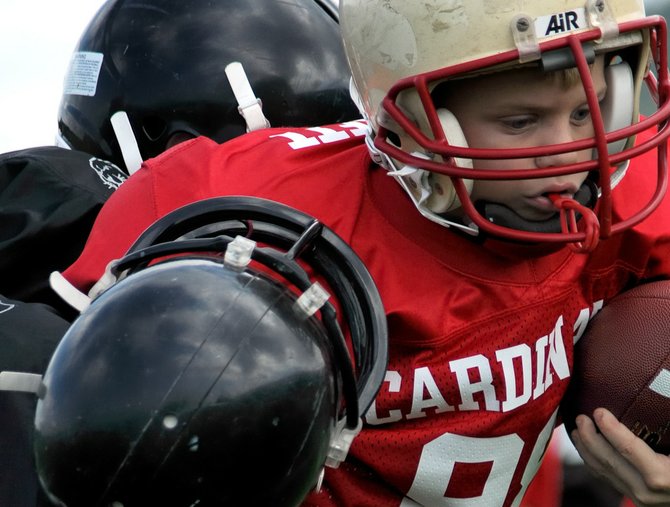Kids playing in Pee Wee, middle school and high school football are at an increased risk for head injury. Photo by Courtesy Flickr/JDanvers
Practicing at the linebacker position, Wesley Ward hit the fullback hard, but he didn't realize how hard. After a few more minutes into the practice at Central Hinds Academy, his vision blurred and his head started to throb. The impact to his head had caused a subdural hematoma—a blood clot—on the right side of his brain. Prompt and skilled medical attention saved his life. He has fully recovered, but he can't remember five months of his life. It was 2008, and Ward was 16.
Brain injuries are serious and can have lifelong consequences. Recently, many people have become more aware of just how serious, between former National Football League players suing over how their concussions were handled and the number of Iraq and Afghanistan veterans returning with traumatic brain injury due to explosions.
Football isn't the only organized sport that causes head injuries, but it is the most frequent. The website for the American Association of Neurological Surgeons lists football as causing nearly 47,000 emergency-room visits for head injuries, followed by baseball and softball with 38,000, basketball with 35,000 and then soccer with 24,000.
"Never cut corners on a brain concussion, especially in youth players, as the brain is in a fragile and developing state," Ward says.
Much of the current attention around brain concussions occurring during youth sports began with Zackery Lystedt in October 2006. At the time, he was a 13-year-old middle-school football player in Washington state. He collapsed from a brain injury when he was allowed back into a game just 15 minutes after suffering a concussion. He spent nine months in a coma and still has not completely recovered.
"Mississippi is the only state without a youth sports concussion law," says Lee Jenkins, executive director of the Mississippi Brain Injury Association. Mississippi Sen. Michael Watson, a Republican from Pascagoula, presented a sports concussion bill in 2012 that passed unanimously in the Senate but died in the Public Health Committee. Watson tried again in 2013 but failed.
The bill, based on the Zackery Lystedt law enacted in many other states, has three parts aimed at organized youth sports in Mississippi. The first requires that everyone involved with youth sports in Mississippi—parents, coaches, athletes, and officials—receive education on concussions. The second part requires any athlete showing symptoms of a concussion to immediately come out of the game or sports activity and not participate for the rest of the day. The last part of the bill requires anyone who has been diagnosed with a concussion to get a release from a qualified medical professional before he or she participates again. Watson, Jenkins and a host of other agencies and organizations are going to try again in 2014 to pass the bill.
Sen. Watson is committed to the cause. "After visiting with a local doctor in our district and learning more about concussions, I felt compelled to do something to help protect our children from the dangers of concussions and their long term effects," he says.
"This legislation is mainly about educating coaches, parents and young athletes and establishing a return-to-play protocol."
Head Injuries by Sport
The following 20 sports and recreational activities represent the categories contributing to the highest number of estimated head injuries treated in U.S. hospital emergency rooms in 2009.
Cycling: 85,389
Football: 46,948
Baseball and Softball: 38,394
Basketball: 34,692
Water Sports (Diving, Scuba Diving, Surfing, Swimming, Water Polo, Water Skiing, Water Tubing): 28,716
Powered Recreational Vehicles (ATVs, Dune Buggies, Go-Carts, Mini bikes, Off-road): 26,606
Soccer: 24,184
Skateboards/Scooters: 23,114
Fitness/Exercise/Health Club: 18,012
Winter Sports (Skiing, Sledding, Snowboarding, Snowmobiling): 16,948
Horseback Riding: 14,466
Gymnastics/Dance/Cheerleading: 10,223
Golf: 10,035
Hockey: 8,145
Other Ball Sports and Balls, Unspecified: 6,883
Trampolines: 5,919
Rugby/Lacrosse: 5,794
Roller and Inline Skating: 3,320
Ice Skating: 4,608
Injuries in Youth
The top 10 sports-related head-injury categories among children ages 14 and younger:
Cycling: 40,272
Football: 21,878
Baseball and Softball: 18,246
Basketball: 14,952
Skateboards/Scooters: 14,783
Water Sports: 12,843
Soccer: 8,392
Powered Recreational Vehicles: 6,818
Winter Sports: 6,750
Trampolines: 5,025
Source: American Association of Neurological Sciences
For more information, reach out to:
Lee Jenkins, Executive Director
Brain Injury Association of Mississippi
2727 Old Canton Road, Suite 191, 601-981-1021
From ThinkFirst Organization:
jfp.ms/TFconcussions
From the CDC:
Read more:


